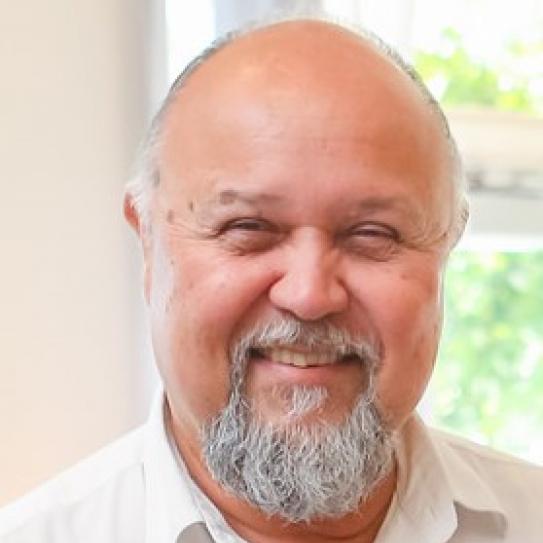Charles Bosley
-
Former Director of Mission Success at Lockheed Martin

Charles Bosley graduated at a transformative time in our school’s history. In 1973 his class became the last to earn degrees from the NYU School of Engineering and Science, located in the picturesque University Heights section of the Bronx. That was the year his alma mater merged with Brooklyn Poly to become the Polytechnic Institute of New York — and later NYU Tandon.
From his current vantage point, it has also been a transformative time in the field of engineering, and with almost 40 years of professional experience under his belt, Bosley, now retired, still marvels at the advancements continually being made.
Bosley began working for the General Electric (GE) Company right after graduation, thanks to a series of successful on-campus interviews, and over the course of his career, he was involved with such entities as GE Electronic Systems, GE Aerospace, and RCA/GE AstroSpace. Later, after Martin Marietta acquired AstroSpace and merged with the Lockheed Corporation, Bosley worked with several Lockheed Martin divisions, including LM Space Systems, Commercial Space Systems, Missile and Space, Communications and Power Center, and LM Electronic Systems. Throughout a dizzying succession of acquisitions, mergers, reorganizations and position changes, he maintained a steady career progression and contributed to the development and implementation of various significant technologies and programs. (His last position title was Director of Mission Success, and interestingly, Lockheed Martin has elevated “Mission Success” to company trademark status.)
He was involved in many projects contracted by the government. “NASA, the Department of Defense, and the National Oceanic and Atmospheric Administration, are just a few of the notable agencies who sponsor and fund technological R&D and implementation programs,” Bosley explains “and some of the technologies and programs I was lucky to work on included space launch vehicles, satellites and spacecraft, radars, navigation systems, and submarine systems from the earliest phases of conceptual design through development and production to launches from Cape Canaveral and other domestic and international launch sites.”
Among the most gratifying phenomena he has witnessed is the transition of government-developed technologies to mainstream civilian and commercial use — and even daily life.
His list is a fascinating one.
- Space Technology: It’s obvious, as Bosley points out, that much of the technology for civilian space programs was developed by or for NASA and the Department of Defense. Rockets, launch vehicles, launch sites and launch pads, satellites, spacecraft, spacesuits, and numerous other technologies needed for space flight — manned or unmanned — are now being used commercially.
- GPS (Global Positioning System), he says, is another obvious example of U.S. government technology now utilized by all tech-savvy (and even many non-tech-savvy) travelers, conceptualized while researchers were looking for improved approaches to LORAN (long range navigation — a technology itself widely applied for civilian use after being developed for military purposes). It was after aircraft mishaps in the 1980s that GPS was made available for civilian use, particularly on aircraft during the 1990s, Bosley relates, and its use has proliferated since.
- Weather satellites developed for the National Oceanic and Atmospheric Administration and the Department of Defense are now major tools for any meteorologist or weather forecaster.
- Communication satellites that can send signals across and between continents or ships at sea, first developed by NASA, are now common tools for many businesses and shipping companies.
- Radars were — and still are — military tools, but they are now also widely used for civilian flight and marine safety as well as weather reporting and forecasting. (“We know any TV meteorologist worth their salt talks about the latest Doppler radars,” Bosley says.)
- Submarine technologies have become particularly popular for scientific exploration, adventure travel, sports, and, of course, as Bosley points out, treasure hunting.
- Gyros, accelerometers, and inertial navigation systems originally developed by NASA and the Department of Defense for rocket and aviation navigation and stability, are now commonly used for quite a variety of civilian applications, including in commercial and private aircraft for stabilization and autopilots. Furthermore, Hollywood filmmakers use gyro-stabilized cameras, and even many cellphones contain gyroscopes and accelerometers, which are particularly useful for games, picture taking, and screen rotation.
“These are just a few examples of technologies I had an opportunity to encounter while working on government contracts before, during, and after their transition to civilian and commercial use,” Bosley says. “The process is ongoing and prolific, and as an engineer, I’m happy to see it.”
One other process Bosley has been happy to see: more women taking on technical leadership roles in the engineering world. He feels lucky to have worked as a peer directly with Marilyn Hewson, who is now Chair, President, and CEO of Lockheed Martin; Hewson was named the most powerful woman in business by Fortune magazine in both 2018 and 2019.“I hear that women make up about 46% of the most recent incoming class at NYU Tandon, and with the school’s strong focus on building an environment in which they can thrive,” he says, “and I wouldn’t be at all surprised if the next Marilyn Hewson turns out to have studied right there in Brooklyn.”

